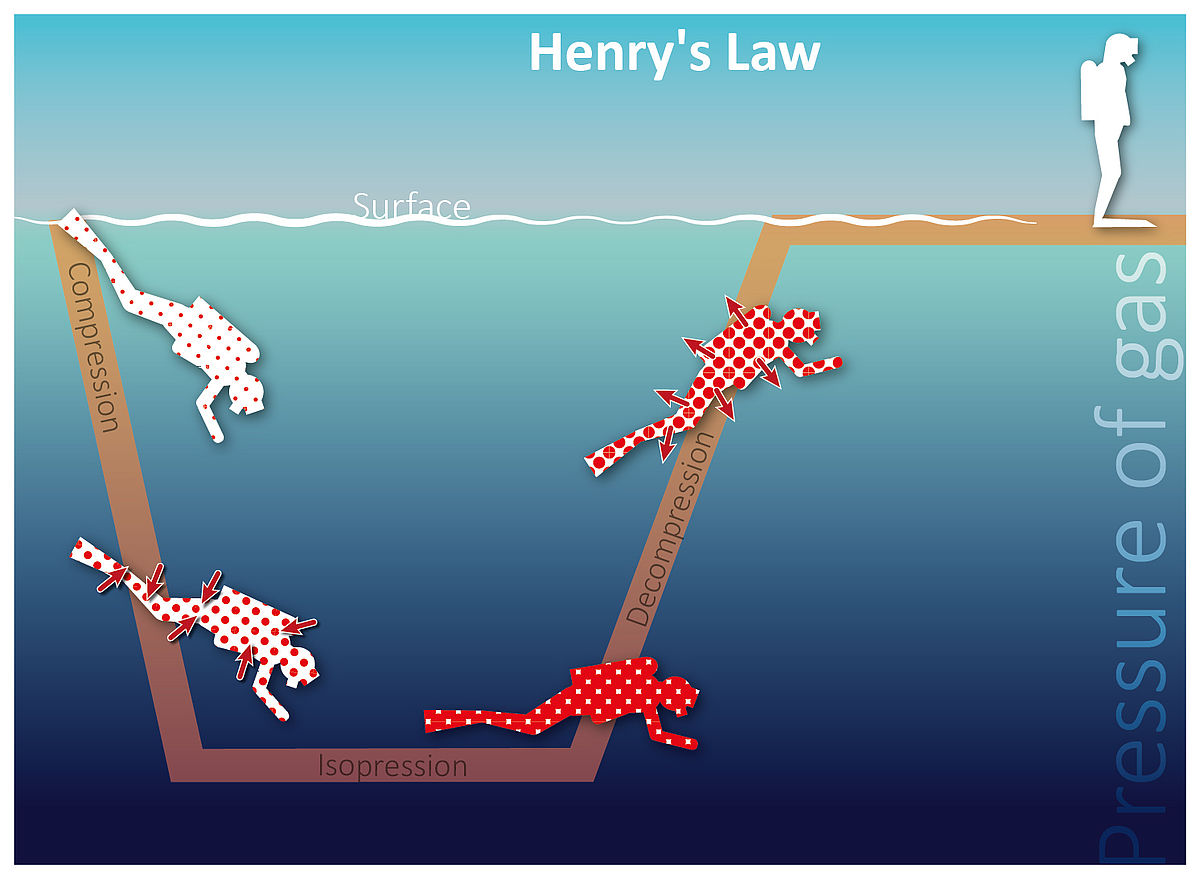
Gas Laws in SCUBA Diving : Safety & How-To + Tips Saveen D 626939
Henry's Law: The molarity/concentration of a gas that is dissolved in a liquid is directly related to the partial pressure above this liquid.
Oxygen and nitrogen are present in blood, and oxygen goes through processes to be consumed by the body. However, nitrogen does not – it says in the bloodstream with no release or change.
As said before, deeper water means deeper partial pressure of nitrogen increases. According to Henry's Law, the concentration of nitrogen in your bloodstream will increase as well.

What Could Happened? Going back up, the concentration reduces again, releasing bubbles into your blood. This can cause Decompression Sickness. These symptoms can range from milld (blisters and etc.), to serious cases which lead to death.
Boyle's Law states : At a constant temperature, as pressure applied increases, the volume of a constant mass decreases. Modelled by the equation: P1V1 = P2V2
As a SCUBA diver descends, the ambient pressure (surrounding water pressure) increases, while air in the body and equipment begins to compress.

This image depicts this principle: As the water gets deeper, air pressure increases, causing volume of gas to decrease.
What do you have to be careful about?
1. Do not hold your breath when going up. At the bottom, inhaled pressure will be larger than at the top (even if it is a smaller difference). When one rises to the top while holding their breath, the new pressure will decrease, and lung volume increases drastically from before. This can cause trauma to the lungs. 2. Ascend slowly. A SCUBA tank is composed of 78% nitrogen, and Boyle's Law proposes that as the diver will come up to the surface, the pressure will decrease, and volume will be inverse. If expanding nitrogen is not released appropriately, it can cause tiny bubbles of nitrogen in the body (Decompression sickness).
The same applies for ascent; as surrounding water pressure decreases, gases begin to expand. These expansions and compressions make it crucial for the driver to equalize pressure in their ears and their buoyancy devices.
Gay-Lussac's Law: P1 / T1 = P2 / T2. As pressure of a gas (at a constant # of moles, volume) , so does its Kelvin temperature (directly related).
In a SCUBA tank, the volume is constant, yet the temperature and pressure will vary throughout the trip. Lower pressure of the gas means less breathable, available gas for one to inhale and can interfere with the diver's safety!

Why might this be an issue? Lower temperature means lower pressure of a constant volume according to this law and lower pressure means less air exiting the gas tank, time under water becomes limited! This limited supply could then cause complications with a diver's breathing and regulation! Tanks exposed to higher temperatures contrarily can damage overtime if let in the sun (for instance, in a car or boat), and have a risk of weakening the outer shell and exploding!
As water gets cooler, the internal temperature gets cooler as well. This directly impacts the internal pressure of a diver's gas tank.
Dalton's Law: The pressure of a gas mixture is the sum of all of its components. PTotal = P1 + P2 + P3 . . .
Oxygen makes up 21% of the SCUBA gas mixture, and nitrogen makes up 78%, with other gases (like helium) making up the remaining amount. As water pressure increases for the diver, this ratio will remain the same within the total pressure, but individual pressures can pose risk to an individual!

Symptoms and Impacts: Oxygen toxicitiy is when rationed oxygen being breathed in exceeds 1.6atm (Around 65-70 metres deep) This has serious effects on a diver like: trouble with vision along with seizures, which can all lead to death. If nitrogen gas levels increase to an extent, this can cause nitrogen narcosis, with symptoms that are more likely to increase with depth! Solutions: Many professionals are able to change the makeup of scuba tanks to ensure that inducing oxygen or nitrogen poisoning is less likely! https://diverswhowanttolearnmore.wordpress.com/2014/08/04/daltons-law/
Thus, as a scuba diver goes deeper into water, the risk of having oxygen or nitrogen intoxication increases because of increased inhalation of these gases. For instance, close to the surface of the water, ratios are quite simple! For 1 Atm measured of gas pressure, it would be 0.21 of Oxygen, and 0.78 of nitrogen. However, as the diver descended to a larger number, these levels can quickly deteriorate health.
Charles' Law: Proposes that as temperature increases, Kelvin temperature will do the same (with a constant volume). V1 / T1 = V2 / T2. This is because gases tend to expand when heat is applied to them.

Background:- Dry suits maintain a sealed amount of air between a diver's warm clothes and the suit itself. Since water pressure begins to decrease as a dive gets deeper & vice versa, one is able to control air in the suit based on different circumstances.
Some tips for dealing with drysuits according to Charles Law: When you finally get back on land, the volume of sealed air will decrease because of the change in temperature (if the air is colder) and can make the suit difficult to get out of. Thus, air can be inserted quickly into the suit to get rid of this vacuum seal effect!
